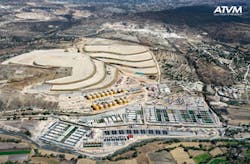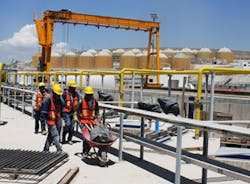Mexico' s New Giant in Town
Set to be one of the world's largest wastewater treatment plants, Mexico's Atotonilco project will treat 3.6 million m3/day and help revitalize local infrastructure. With such an enormous project, what technical and logistic challenges have been faced?
By Mauro Nogarin
For more than 100 years wastewater from the Valley of Mexico has been used for agricultural activity in the Mezquital Valley in Hidalgo, where it currently irrigates more than 90 thousand hectares of crops with wastewater.
Excess wastewater flows and stormwater runoff have been redirected to the Tula Valley watershed to the north. Despite the nutrient rich waters transforming what was arid land into highly productive irrigation district, the untreated waters have led to sanitary and environmental problems.
Cleaning up Mexico
As a result, the National Water Commission (Conagua) has embarked on a $1.4 billion long-term sustainable water management programme. One component of this is the
Atotonilco wastewater treatment plant (WWTP) – currently 85% complete and set for opening in February 2015 - which is hoped to help improve the local environment.
Around 80,000 hectares of agricultural land in the Tula Valley will be irrigated using treated effluent from Atotonilco. The cost of the project is US$786 million for a design, build, operate and transfer (DBOT) contract with CH2M Hill acting as the owner's engineer.
The project was assigned by CONAGUA to Aguas Tratadas del Valle de Mexico (ATVM) in December 2009, a consortium comprising several industry entities.
ATVM looks to collate the efforts of IDEAL, Atlatec, Acciona Agua, Infrastructure Operations Controller (CONOISA), Construction and Urban Development (DYCUSA) and Green Gas Pioneer Crossing Energy into the design, execution, installation and testing phases of the project over a 25-year period.
Called the world's largest wastewater treatment plant, Atotonilco will have a maximum treatment capacity of 3.6 million m3/day. It will clean almost 60% of wastewater produced by the Metropolitan Area of Mexico City (compared to 8% beforehand), which has a population over 20 million. Methane gas from the sludge treatment process will produce 60% of the electricity consumed by the plant, reducing its reliance on external energy sources.
Treatment process
After initial treatment, the secondary treatment system will see 24 modules comprising of aerobic reactors and secondary clarifiers. The primary effluent feeds distribution boxes by means of the pumps and will be equally distributed to the anaerobic reactors.
Secondary sedimentary sludge will be suctioned by means of air-lift and directed toward the gutters that return the sludge to the inlet chamber of each biological reactor, as well as the purge pumps of sludge that sends them to the stage of thickening.
The process is made up of the physical-chemical reactors, lamellar decanting, thickeners, rotating mesh filters and disinfection. The pumping of water to the Salto of Tlamaco canal has the objective of mainly reducing suspended solids and biochemical oxygenation.Water then enters the flocculation chamber and the recirculation chimney. Within this chimney there is a turbine, which rotates at a slow speed that allows the growth and the grouping of micro-floccules. The planned reagents are ferric chloride as a coagulant and polymers as flocculants.
Once the filtered water are disinfected they can be discharged by gravity to the Tula River and through pumping to the Salto of Tlamaco Canal.
This depends on the needs of the sites that are fed from these sources for irrigation. The thickened sludge in the decanters (thickened through gravity), are pumped to two sieve filters with 230 m³/h flow and a 3 mm light unit. The sludge, once sieved along with oils and fats, falls by gravity to the reservoir for homogenization.
Meeting standards
Concentrated sludge is removed from the bottom of each thickener, through a pressure independent control (PIC) valve and is pumped into the tank for homogenization for onward shipment to each one of the anaerobic digesters.
The anaerobic digestion is designed to obtain a quality sludge which meets Mexican Official Standards NOM-004-SEMARNAT-2002. Sludge digestion is performed in digesters of 13,000 m³, arranged in two completely separate groups, each composed of 14 units.
Volatile materials that are found in the digested sludge will undergo a process of molecular breakage, resulting in a final product containing CH4 and CO2, as well as other gases such as SH2, and saturated water vapor at that temperature.
Below each of the two centrifuges there will be a screw injector installed that collects the sludge drained for transporting them through two screws to a silo with two 30 m³ hoppers. The disposal of sludge will be carried out in a mono-fill built for this purpose, in which they will deposit the mud for drying and final disposal.
With the gas produced in anaerobic digestion, which is fed to 12 cogeneration engines, the electrical energy produced by this mean will power the plant.
********************
Interview: Aldo Salmeron Cortés, Director of ATVM
Q: This is an enormous financial and logistical effort which requires a great deal of man hours.
A: Indeed, financially, because it is a project worth about US$786 million, it's a great effort for the financial structuring of investment and public-private appropriations. Logistically, of course, it involves building a huge project on a very irregular surface, which requires just over 180 MDP monthly cost, coordinating high volumes of materials and controlling the manufacture and shipment of more than 1,200 pieces of heavy equipment from around the world, especially from Europe and North America. Labour, is perhaps the most complex issue of all: it got to the point where we had peaks of 2,400 workers and 450 professionals from all specialties.
Q: What were the biggest technical challenges facing the construction of the Atotonilco?
A: Virtually everything in this project involved major challenges. Do not forget that once in operation this will be the fourth largest water treatment plant in the world, and the world's largest to be built as one single project. This project is certainly a global milestone.
Q: With the completion of the 62km long tunnels, Mexico City will become a model capital for other countries in Latin America. Do you expect other cities to do the same?
A: Without a doubt, these two works developed by the Federal Government, by Conagua, will account for a major advance in the evacuation of wastewater and stormwater from the Valley of Mexico. This is as well as providing flood protection to the valley's population, not forgetting the sustainability component to increase levels of treatment in the most populous area. We now have an example in the world in the implementation of sustainable water works for large cities with this type of problem.
Mauro Nogarin is a freelance contributor for WWi magazine. For more information, email: [email protected]



